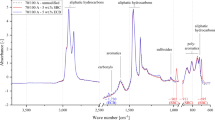Abstract
The aim of this work was to determine models for the characterisation of bitumen based on the Fourier transform infrared (FTIR) spectroscopy and a chemometrical evaluation of the spectra. For this, 90 bitumen samples were investigated using the attenuated total reflexion technology with multiple reflexions. The gained spectra were divided into two partial spectra with the relevant peaks and pre-processed with a Standard Normal Variate transformation and the first derivative. For a comprehensive evaluation, multivariate analysis methods in terms of the factor analysis and the discriminant analysis were used. Based on the pre-processed spectra and the evaluation methods, models could be determined allowing the differentiation of bitumen samples according to the refinery and the ageing state. Concerning the long-term aged states, a simultaneous consideration of samples from different refineries is possible while, for the differentiation of the unaged and the short-term aged states, the separate consideration of the different refineries is necessary. Thus, the FTIR spectroscopy as a fast investigation method enables the first characterisation of bitumen samples according to the refinery and the ageing state.








Similar content being viewed by others
References
Hunter RN, Self A, Read J (2015) The shell bitumen handbook. Thomas Telford, London
Weigel S, Stephan D (2017) Relationships between the chemistry and the physical properties of bitumen. Road Mater Pavement Des. https://doi.org/10.1080/14680629.2017.1338189
Weigel S, Stephan D (2017) Modelling of rheological and ageing properties of bitumen based on its chemical structure. Mater Struct. https://doi.org/10.1617/s11527-016-0957-7
Günzler H, Gremlich HU (2002) IR spectroscopy. Wiley, Weinheim
Lu X, Isacsson U (2002) Effect on ageing on bitumen chemistry and rheology. Constr Build Mater 16:15–22. https://doi.org/10.1016/S0950-0618(01)00033-2
ValckeE Rorif F, Smets S (2009) Ageing of Eurobitum bituminised radioactive waste: an ATR-FTIR spectroscopy study. J Nucl Mater 393:175–185. https://doi.org/10.1016/j.jnucmat.2009.06.001
Wu S, Pang L, Liu G, Zhu J (2010) Laboratory study on ultraviolet radiation aging of bitumen. J Mater Civ Eng 22:767–772. https://doi.org/10.1080/10916466.2018.1465962
van den Bergh W (2011) The effect of ageing on the fatigue and healing properties of bituminous mortars. Dissertation, TechnischeUniversiteit Delft
Mouillet V, Farcas F, Besson S (2008) Ageing by UV radiation of an elastomer modified bitumen. Fuel 87:2408–2419. https://doi.org/10.1016/j.fuel.2008.02.008
Fernández-Gomez WD, Quintana HAR, Daza CE (2014) The effects of environmental aging on Colombian asphalts. Fuel 115:321–328. https://doi.org/10.1016/j.fuel.2013.07.009
Wu S, Pang L, Mo L, Chen Y, Zhu G (2009) Influence of aging on the evolution of structure, morphology and rheology of base and SBS modified bitumen. Constr Build Mater 23:1005–1010. https://doi.org/10.1016/j.conbuildmat.2008.05.004
Smiljanić M, Stefanocić J, Neumann HJ, Rahimian I, Jovanović J (1993) Ageing of asphalt on paved roads. Erdöl und Kohle 46(6):238–244
Feng Z, Bian H, Li X, Yu J (2016) FTIR analysis of UV aging bitumen and its fractions. Mater Struct 49:1381–1389. https://doi.org/10.1617/s11527-015-0583-9
Feng Z, Yu J, Zhang H, Kuang D, Xue L (2013) Effect of ultraviolet aging on rheology, chemistry and morphology of ultraviolet absorber modified bitumen. Mater Struct 46:1123–1132. https://doi.org/10.1617/s11527-012-9958-3
KisterJ Piéri N, Gemanaud L (1993) Etude du vieillissement des bitumes par fluorescence en excitation-emission synchrones (EES) et par IRTF. Pr Assoc Asphalt Paving Technologists 30:359–372
Lamontagne J, Dumas P, Mouillet V, Kister J (2001) Comparison by Fourier transform infrared (FTIR) spectroscopy of different ageing techniques: application to road bitumens. Fuel 80:483–488. https://doi.org/10.1016/S0016-2361(00)00121-6
Janssen J, Laatz W (2013) Statistische datenanalyse mit SPSS. Springer, Berlin
Fahrmeir L, Künstler R, Pigeot I, Tutz G (2007) Statistik—Der Weg zur Datenanalyse. Springer, Berlin
Weigel S, Stephan D (2017) The prediction of bitumen properties based on FTIR and multivariate analysis methods. Fuel 208:655–661
Thimm L (2009) FT-IR und FT-NIR spektroskopische Untersuchungen in Kombination mit chemometrischen Auswertealgorithmen zur Charakterisierung der chemischen Zusammensetzung von Straßenbaubitumen. Dissertation, Universität Duisburg-Essen
de Peinder P (2009) Characterization and classification of crude oils using a combination of spectroscopy and chemometrics. Dissertation, Univeristeit Utrecht
Kessler W (2007) Multivariate datenanalyse. Wiley, Weinheim
Piéri N, Planche JP, Martin D, Germanaud L, Kister J (1996) A new approach to predict rheological properties of bitumen from their chemical composition determined by FTIR and synchronous U.V. fluorescence. In: Proceedings of the 1st Eurasphaltand Eurobitumen Congress (Straßbourg), vol 5(120), pp 1–13
Gottwald W, Wachter G (1997) IR-Spektroskopie für Anwender. Wiley, Weinheim
Backhaus K, Erichson B, Plinke W, Weiber R (2011) Multivariate analysemethoden. Springer, Berlin
Neumann HJ (1987) Oxidationsverhalten von Bitumen bei Gebrauchstemperaturen. ErdölErdgasKohle 3:131–133
Standards
EN 12591 (2009) Bitumen and bituminous binders—specifications for paving grade bitumens
EN 12607-1 (2007) Bitumen and bituminous binders—determination of the resistance to hardening under the influence of heat and air—part 1: RTFOT Method
EN 12607-3 (2007) Bitumen and bituminous binders—determination of the resistance to hardening under the influence of heat and air—part 3: RFT Method
EN 14769 (2012) Bitumen and bituminous binders—accelerated long-term ageing conditioning by a Pressure Ageing Vessel (PAV)
GESTRATA leaflet 01 (2008) Alterungsbeständigkeit von Straßenbaubitumen
Acknowledgements
The authors would like to thank Professor Dr. Martin Radenberg and Dr. Volker Hirsch for the support and the expert advices. Furthermore, the authors would like to thank Dr. Norbert Simmleit for the provided bitumen samples.
Funding
This report is based on parts of a research project carried out at the request of the German Federal Ministry of Transport and Digital Infrastructure, represented by the German Federal Highway Research Institute, under research project No. 7.0249/2011/BRB and on parts of a research project carried out at the request of the German Federal Ministry of Education and Research, represented by The Association of German Engineers, under research project No. 13N13109. The authors are solely responsible for the content.
Author information
Authors and Affiliations
Corresponding author
Ethics declarations
Conflict of interest
The authors declare that they have no conflict of interest.
Rights and permissions
About this article
Cite this article
Weigel, S., Stephan, D. Differentiation of bitumen according to the refinery and ageing state based on FTIR spectroscopy and multivariate analysis methods. Mater Struct 51, 130 (2018). https://doi.org/10.1617/s11527-018-1252-6
Received:
Accepted:
Published:
DOI: https://doi.org/10.1617/s11527-018-1252-6




